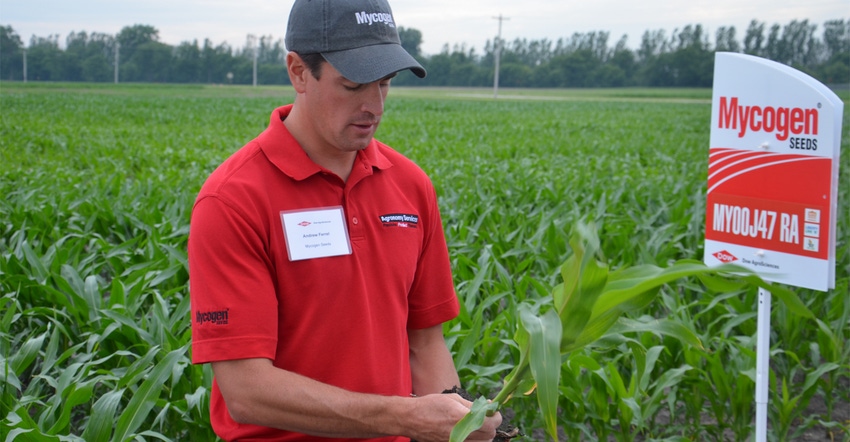
Andrew Ferrel and Melissa Bell had all kinds of plants pulled from cornfields and lying around them when they talked about the 2017 season recently. Most were examples of things that had gone wrong somewhere this year.
Ferrel and Bell are commercial agronomists for Mycogen Seeds — Ferrel in Indiana, Bell in Illinois.
Here are six lessons they believe are worth taking away from the season so far.
1. Sporadic weather conditions result in a highly variable crop. “We had a good start, with lots of corn planted in April,” Ferrel observes. “Then the weather did a 180-degree turn and went cold and wet. The result was corn from the VE, or emergence stage, to V12, or 12th leaf stage, by late June. That means farmers have to make decisions field by field.”
2. Only armchair quarterbacks could pinpoint the dates not to plant. “It turns out that corn planted April 21 to April 23 tended to struggle,” Bell says. “That’s because much of our region received heavy rains over several days, and it turned cool. There are always days which are the wrong days to plant. The problem is you can’t predict them in advance, and this season emphasized that again.”
3. Seedling diseases and insects can cause a corn stand to go backward. This year proved that just because you counted 32,000 plants per acre one week doesn’t mean you will have that many the next week. Bell ran into situations where seedling blights such as pythium and fusarium took out plants later.
4. You should save a stand if you can. When you have stands of 17,000 to 20,000 corn plants per acre, whether to replant is a difficult decision, Ferrel says. But he leans toward keeping a stand, if possible. If you replant corn very late, you’re at the mercy of not only July weather, but also August weather, he notes.
5. Weeds gain an advantage when wet weather drags out after herbicide application. “One reason we saw more weed escapes was because residual herbicides began to run out of steam before many weeds germinated,” Bell observes. “When a residual herbicide is applied early and it turns wet and cool, the herbicide may break down before it’s needed the most.”
6. Secondary pest pressure was more damaging than usual. When corn seedlings are slow getting out of the ground, it’s an opportunity for secondary pests to have a picnic. Ferrel believes that happened in some fields this year. He found white grubs in several fields. When corn growth is slow, pests such as grubs have a better opportunity to cause damage.
About the Author(s)
You May Also Like




